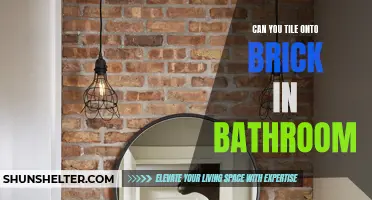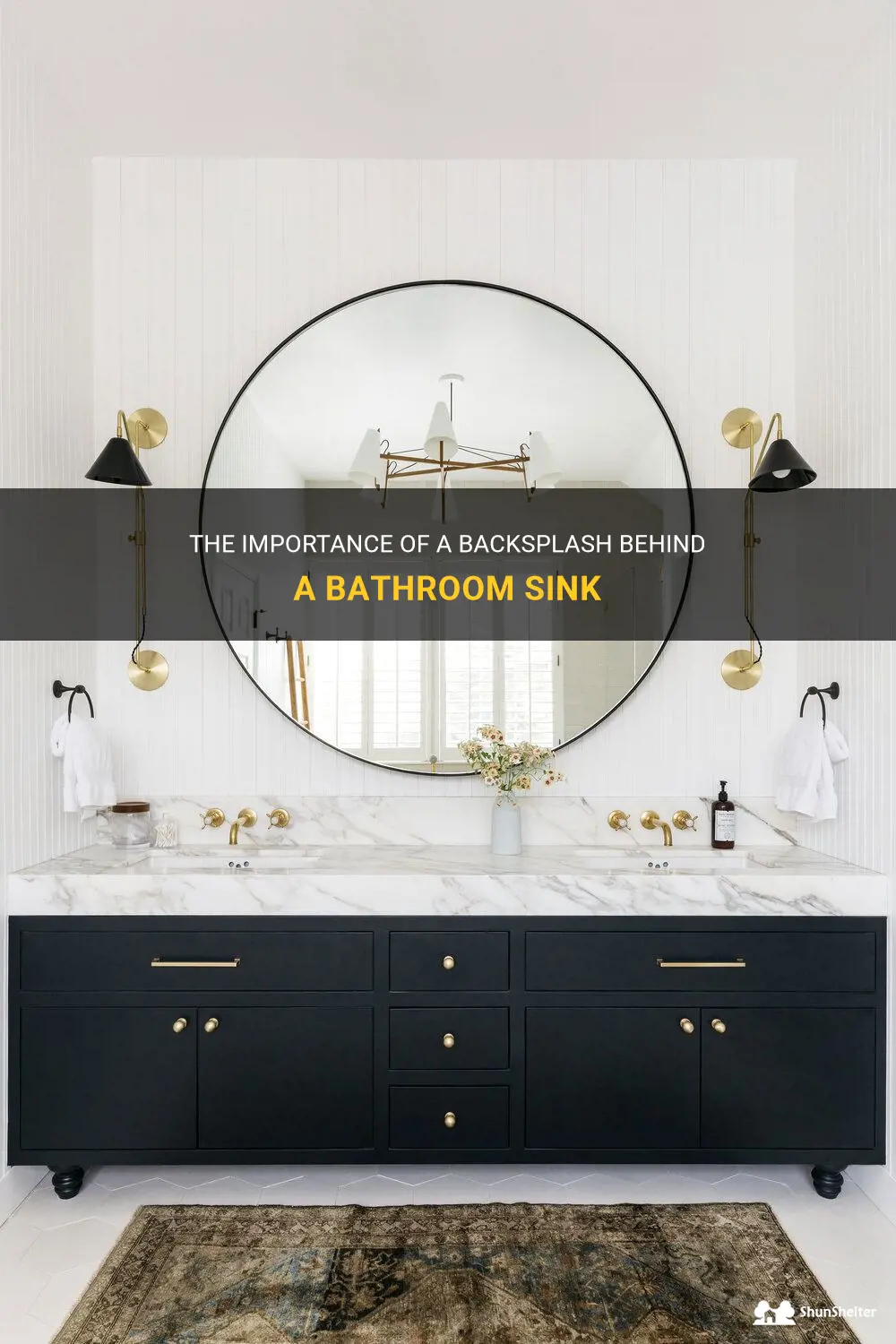
Should there be a backsplash behind a bathroom sink? This age-old question has left homeowners and interior designers pondering for years. Some argue that a backsplash is necessary to protect the wall from water damage and splashes, while others believe it is simply a decorative element that adds visual appeal to the space. In this article, we will explore the pros and cons of having a backsplash behind a bathroom sink, ultimately leaving the decision in your hands. So, let's dive in and discover whether a backsplash is a must-have or just a nice-to-have in your bathroom design!
What You'll Learn
- What is the purpose of having a backsplash behind a bathroom sink?
- How does a backsplash protect the wall behind a bathroom sink from water damage?
- Are there any alternative options to a backsplash for protecting the wall behind a bathroom sink?
- Does a backsplash add aesthetic value to a bathroom sink area?
- What are the different materials that can be used for a backsplash in a bathroom sink area?

What is the purpose of having a backsplash behind a bathroom sink?
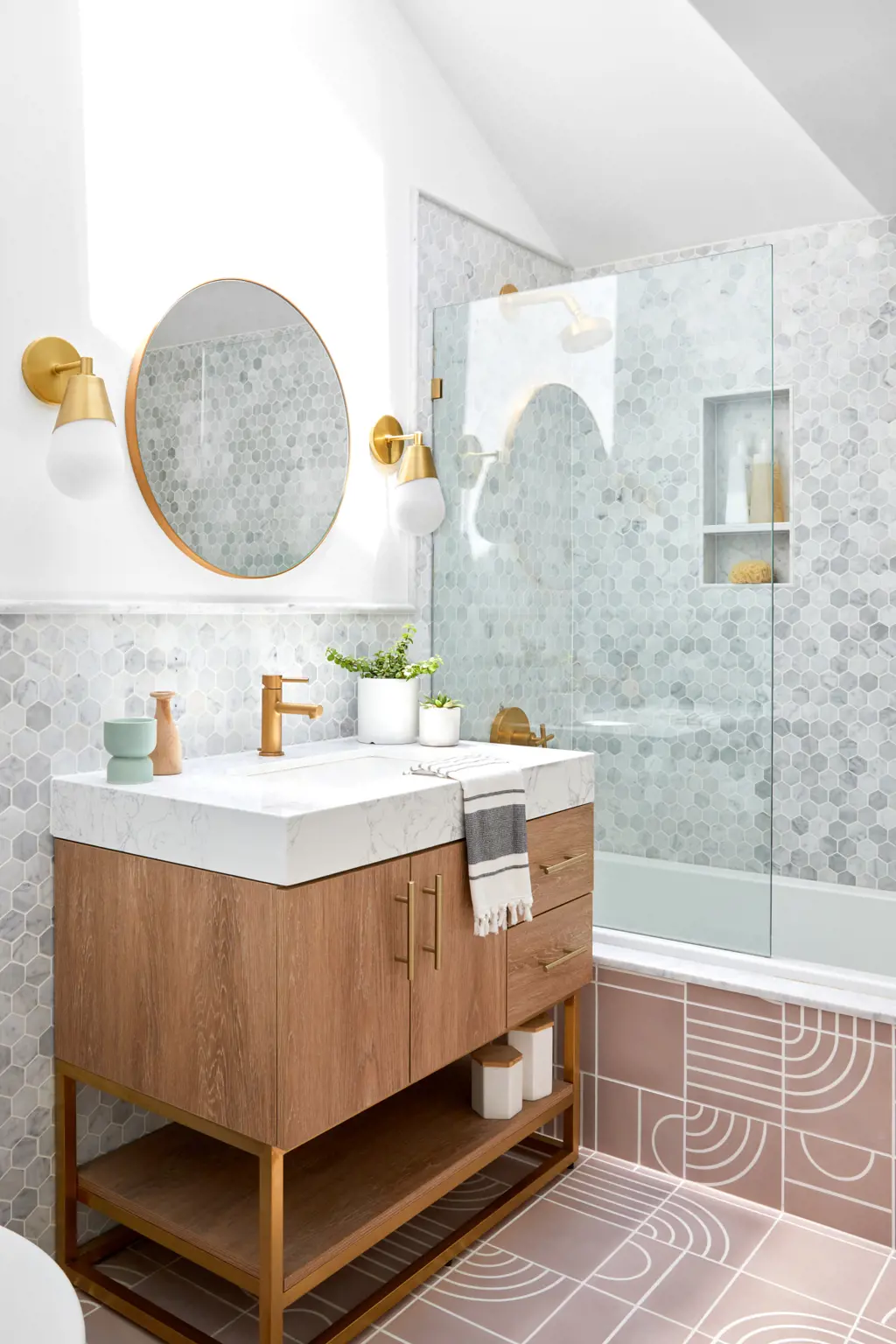
A backsplash is a panel that is typically made of ceramic or glass and is installed behind a bathroom sink. It serves both functional and aesthetic purposes. In this article, we will explore the reasons why having a backsplash behind a bathroom sink is important.
- Protecting the wall from water damage: One of the main reasons for having a backsplash is to protect the wall behind the sink from water damage. When you use the sink, water can splash onto the wall, leading to discoloration, peeling paint, or even mold growth. A backsplash acts as a barrier between the sink and the wall, preventing any water from reaching the wall surface. This helps to maintain the structural integrity of the wall and keeps it looking clean and pristine.
- Easy maintenance and cleaning: With a backsplash in place, cleaning the area behind the sink becomes much easier. The smooth, non-porous surface of a backsplash makes it resistant to stains, and any splatters from toothpaste, soap, or other products can be easily wiped away. This reduces the need for frequent repainting or expensive repairs.
- Adds visual appeal: Besides its practical benefits, a backsplash can enhance the overall aesthetic appeal of the bathroom. It adds a touch of style and can be a focal point in the room. The choice of material, color, and design can be customized to match your personal taste and complement the existing decor. With a vast range of options available, you can choose a backsplash that reflects your personality and adds visual interest to the space.
- Increases property value: Installing a backsplash in the bathroom can also increase the value of your property. Potential buyers often look for well-maintained bathrooms with stylish features, and a quality backsplash can make a strong impression. It shows that you have taken the time and effort to invest in the appearance and functionality of your bathroom, which can be an attractive selling point.
Step-by-step installation of a bathroom sink backsplash:
- Measure the area: Start by measuring the width and height of the wall where you want to install the backsplash. This will help you determine the size and quantity of tiles or panels needed.
- Choose the material: Decide on the material you want for your backsplash. Ceramic tiles and glass panels are popular choices, but you can also consider other options like porcelain, metal, or even natural stone. Make sure the material is suitable for a wet environment and easy to clean.
- Prepare the wall: Before installation, ensure that the wall is clean and free of any debris. Remove any existing wallpaper, paint, or loose material. If necessary, apply a coat of primer to create a smooth surface for the backsplash.
- Install the backsplash: Apply the adhesive or mortar to the wall using a trowel, following the manufacturer's instructions. Press the tiles or panels firmly onto the adhesive, starting from the bottom and working your way up. Use spacers to create even gaps between the tiles or panels. Let the adhesive dry according to the recommended time.
- Grouting and sealing: Once the adhesive is dry, remove the spacers and begin grouting the joints between the tiles or panels. Apply the grout with a grout float, making sure to fill all the gaps. Wipe off any excess grout with a damp sponge. After the grout has dried, apply a sealant to protect the backsplash from stains and water damage.
Examples of stylish backsplash designs:
- Subway tiles: Subway tiles are a classic choice that never goes out of style. They are rectangular-shaped tiles often arranged in a brickwork pattern. Subway tiles come in various colors and finishes, allowing for endless design possibilities.
- Mosaic tiles: Mosaic tiles are small tiles that are arranged to form a pattern or image. They can add a pop of color and create a focal point behind the sink. Mosaic tiles are available in a wide range of materials, including glass, ceramic, and natural stone.
- Mirrored backsplash: A mirrored backsplash can make a small bathroom appear larger and brighter. It reflects light and adds a touch of glamour to the space. Mirrored backsplashes are available as individual panels or as tiles with a mirrored surface.
In conclusion, having a backsplash behind a bathroom sink serves multiple purposes. It protects the wall from water damage, makes cleaning easier, adds visual appeal, and can increase the value of your property. Whether you choose a classic subway tile, a colorful mosaic pattern, or a mirrored backsplash, installing one can enhance the functionality and aesthetic of your bathroom.
Creating a Stunning Bathroom Sink Backsplash with Tile: A Step-by-Step Guide
You may want to see also

How does a backsplash protect the wall behind a bathroom sink from water damage?
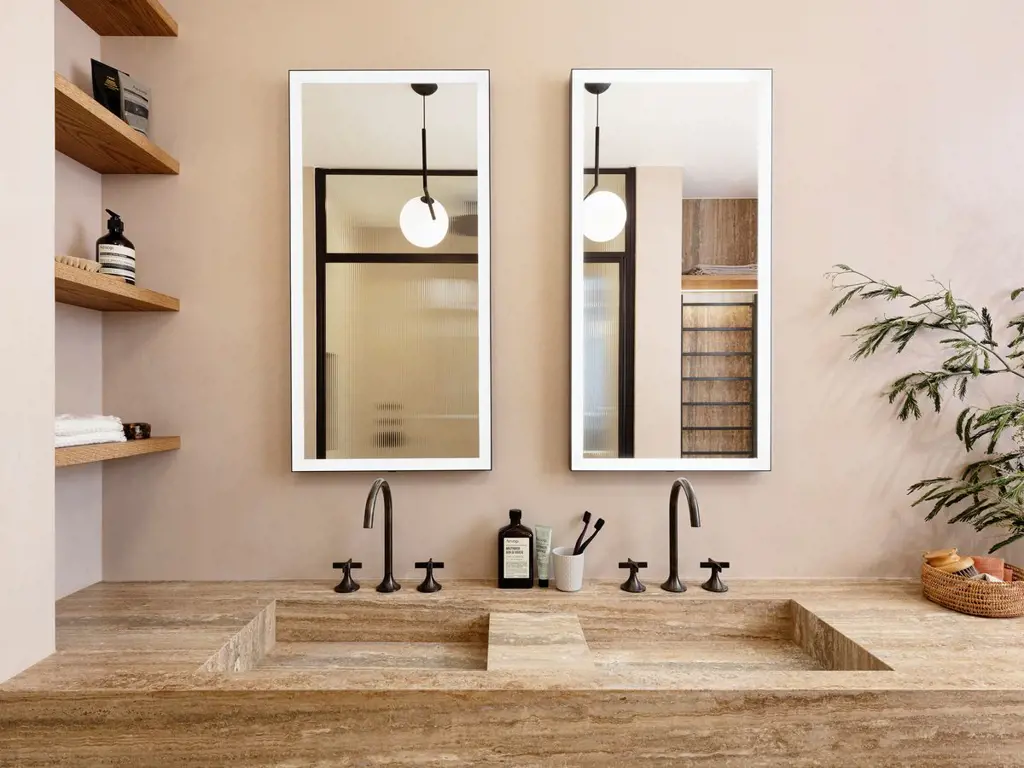
A backsplash is a protective barrier that is installed above a bathroom sink to prevent water damage to the wall. It serves as a barrier between the sink and the wall, catching water that splashes out of the sink and preventing it from reaching the wall.
Water damage can occur when water comes into direct contact with the wall, causing it to become damp and potentially leading to mold and mildew growth. The use of a backsplash helps to minimize this risk by creating a barrier that prevents water from reaching the wall.
There are several ways in which a backsplash protects the wall from water damage. Firstly, the backsplash is typically made of materials that are resistant to water, such as tile, glass, or stone. These materials are designed to repel water and prevent it from seeping through to the wall. Additionally, backsplashes are often sealed with a waterproof grout or caulk, further enhancing their water resistance.
Secondly, the height of the backsplash plays a crucial role in protecting the wall. A well-designed backsplash should extend a few inches above the highest point of the sink, ensuring that any splashes or spills are contained within the area of the backsplash. This prevents water from reaching the wall and causing damage.
In addition to acting as a barrier, a backsplash also makes it easier to clean up any water that does splash out of the sink. The smooth surface of the backsplash allows for easy wiping and prevents water from pooling on the wall. This helps to prevent water damage and also promotes better hygiene in the bathroom.
To install a backsplash, several steps must be followed. Firstly, the area behind the sink must be prepared by cleaning and ensuring it is free of any debris. Any existing wallpaper or paint should be removed, and the wall should be smooth and even.
Next, the backsplash material should be chosen. Tile is a popular choice due to its versatility and water resistance. Glass and stone are also commonly used materials for backsplashes. The chosen material should be cut to fit the size of the area and be laid out in a pattern or design, if desired.
The backsplash is then adhered to the wall using an appropriate adhesive, such as thinset mortar for tile or a strong adhesive for glass or stone. It is important to ensure that the adhesive is evenly applied and that the backsplash is pressed firmly against the wall to create a strong bond.
Finally, the backsplash is grouted or caulked to seal any gaps between the tiles or stones. This step is crucial in preventing water from seeping behind the backsplash and potentially reaching the wall. The grout or caulk should be allowed to dry completely before the sink is used or any water is splashed near the backsplash.
In conclusion, a backsplash serves as a protective barrier that prevents water damage to the wall behind a bathroom sink. Through its water-resistant materials and proper installation techniques, it acts as a barrier between the sink and the wall, catching water and preventing it from reaching the wall. By following the appropriate steps and using the right materials, a backsplash can effectively protect the wall from water damage and promote a clean and hygienic bathroom environment.
The Ultimate Guide to Installing a Bathroom in Your Basement
You may want to see also

Are there any alternative options to a backsplash for protecting the wall behind a bathroom sink?
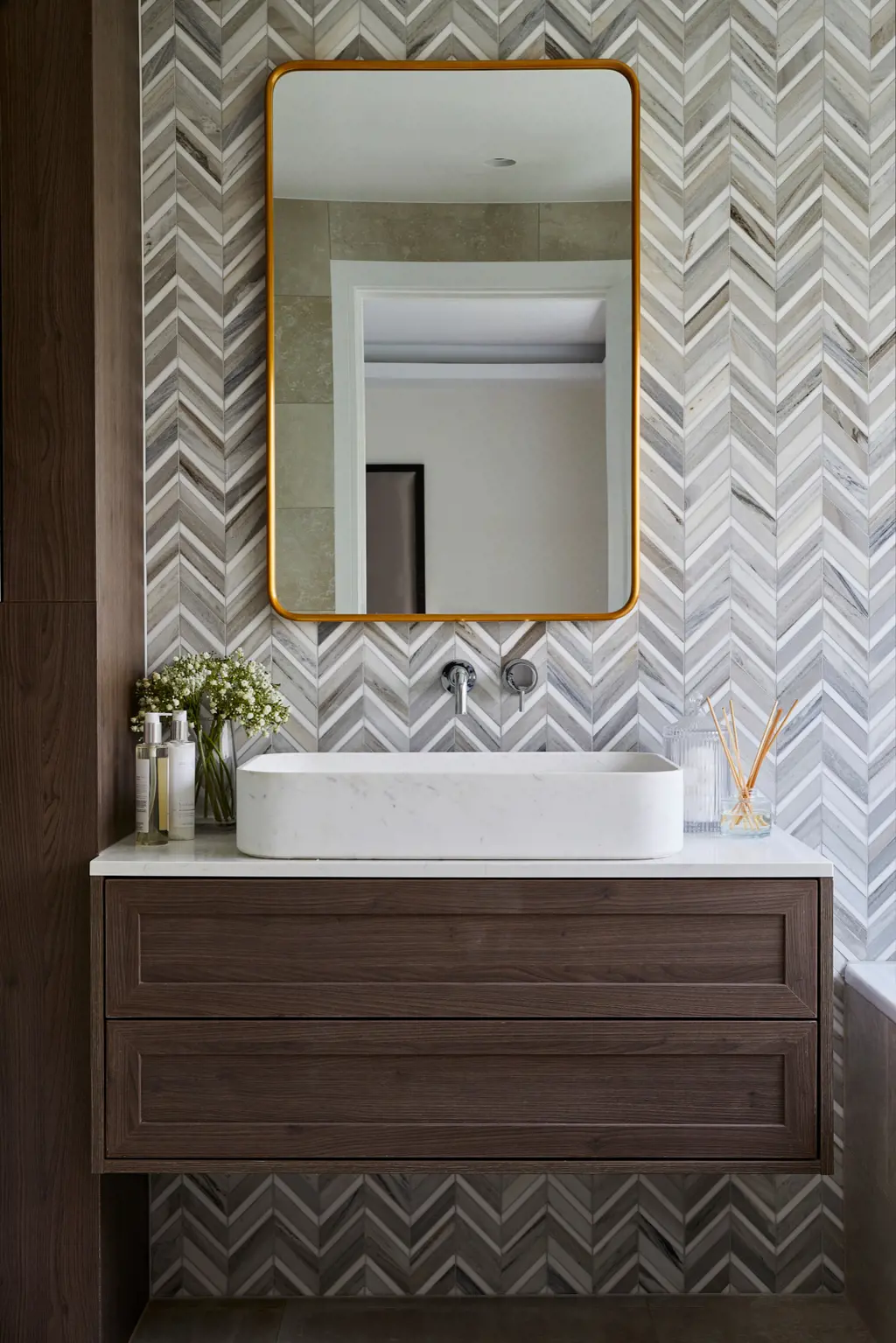
When it comes to protecting the wall behind a bathroom sink, a traditional backsplash made of tile or other waterproof material is a popular choice. However, if you're looking for alternative options, there are a few creative ideas that can still offer protection and add style to your bathroom.
One alternative option is a wallpaper with a moisture-resistant coating. There are many wallpaper designs available that are specifically designed for use in bathrooms, with water-resistant properties that can withstand the humidity and occasional splashes. These wallpapers are often made with vinyl or other water-resistant materials, making them a durable and stylish choice for protecting your bathroom walls.
Another option is to use a waterproof paint or sealant on your bathroom walls. While this may not be as decorative as a traditional backsplash or wallpaper, it can still provide a functional barrier against moisture. Look for a paint or sealant specifically designed for use in bathrooms or high-moisture areas, as these products are formulated to resist mold and mildew growth. Be sure to properly prepare the wall surface before applying the paint or sealant, as any existing moisture or damage can compromise the effectiveness of the barrier.
If you're looking for a more modern and minimalist option, consider using a sheet of tempered glass as a backsplash alternative. Tempered glass is a durable and easy-to-clean material that can be easily installed behind your bathroom sink. It provides a sleek and seamless look, while also providing protection against moisture. You can choose a clear glass for a minimalist look, or opt for a frosted or patterned glass for added privacy and style.
In addition to these alternative options, there are also some simple DIY solutions that can offer protection for your bathroom walls. For example, you can use a peel-and-stick backsplash, which is a self-adhesive tile or wallpaper that can be easily installed and removed without causing damage to the wall. This option allows you to experiment with different designs and styles, without the commitment of a permanent installation.
Ultimately, the choice of an alternative option to a traditional backsplash for protecting the wall behind a bathroom sink will depend on your personal style preferences and budget. Whether you opt for a moisture-resistant wallpaper, waterproof paint, tempered glass, or a simple DIY solution, the important thing is to ensure that your bathroom walls are protected against moisture and damage. This will not only preserve the aesthetic appeal of your bathroom, but also prolong the life of your walls and prevent costly repairs in the future.
Maintaining Dignity: Exploring the Issue of Privacy in Prison Bathrooms
You may want to see also

Does a backsplash add aesthetic value to a bathroom sink area?
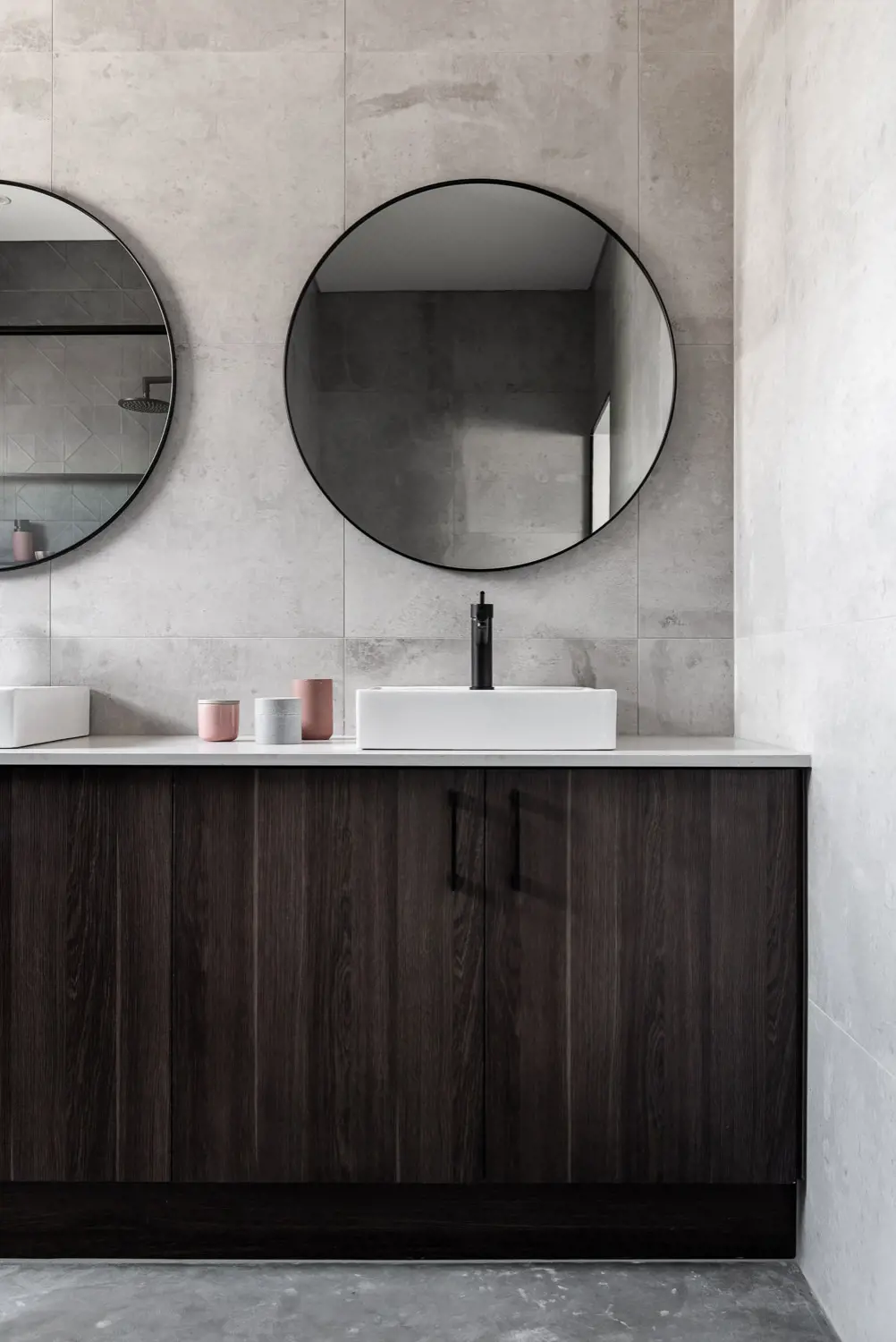
A backsplash is a vertical surface that is installed behind a bathroom sink to protect the wall from water damage and to add aesthetic value to the space. It is typically made of tiles or other waterproof materials such as glass or metal.
But does a backsplash really add aesthetic value to a bathroom sink area? The short answer is yes. A backsplash can greatly enhance the overall look and feel of a bathroom, making it appear more polished and well-designed.
Here are a few reasons why a backsplash is a valuable addition to any bathroom sink area:
- Visual appeal: A backsplash can instantly transform a plain and boring bathroom sink into a visually appealing focal point. With a wide range of colors, textures, and patterns available, you can easily find a backsplash that complements your bathroom decor and adds an element of interest to the space.
- Protection: One of the main purposes of a backsplash is to protect the wall behind the sink from water damage. Without a backsplash, water can seep into the drywall, leading to mold and mildew growth, as well as structural issues. By installing a backsplash, you can prevent these problems and ensure the longevity of your bathroom.
- Easy to clean: Bathrooms can get messy, especially around the sink area. With a backsplash, you can easily wipe away any splashes or spills, keeping your bathroom clean and hygienic. Tiles, in particular, are known for their durability and ease of maintenance, making them ideal for use as a backsplash.
Now that we understand the benefits of a backsplash, let's take a look at how to install one step-by-step:
Step 1: Prepare the wall. Ensure that the wall is clean and free from any debris or grease. If necessary, patch any holes or uneven surfaces.
Step 2: Measure and cut the tiles. Use a tape measure to determine the dimensions of your backsplash area. Transfer these measurements onto the tiles and use a tile cutter to cut them to size.
Step 3: Apply adhesive. Use a notched trowel to spread a layer of tile adhesive onto the wall, ensuring even coverage.
Step 4: Install the tiles. Press each tile firmly into the adhesive, starting from the bottom and working your way up. Use spacers to maintain a consistent gap between tiles.
Step 5: Allow the adhesive to dry. Follow the manufacturer's instructions for drying time. Once the adhesive is fully dried, remove the spacers.
Step 6: Apply grout. Mix the grout according to the manufacturer's instructions and apply it to the gaps between the tiles using a grout float. Remove any excess grout with a damp sponge.
Step 7: Clean and seal the tiles. After the grout has dried, use a clean, damp cloth to remove any grout haze from the tile surface. Once the tiles are clean and dry, apply a grout sealer to protect them from staining and water damage.
In conclusion, a backsplash adds aesthetic value to a bathroom sink area by enhancing its visual appeal, protecting the wall from water damage, and making it easy to clean. With proper installation and maintenance, a backsplash can be a valuable addition to any bathroom. So, if you're looking to upgrade your bathroom, consider installing a backsplash for a functional and stylish touch.
Is It Safe to Have a Bathroom Below the Flood Plain?
You may want to see also

What are the different materials that can be used for a backsplash in a bathroom sink area?
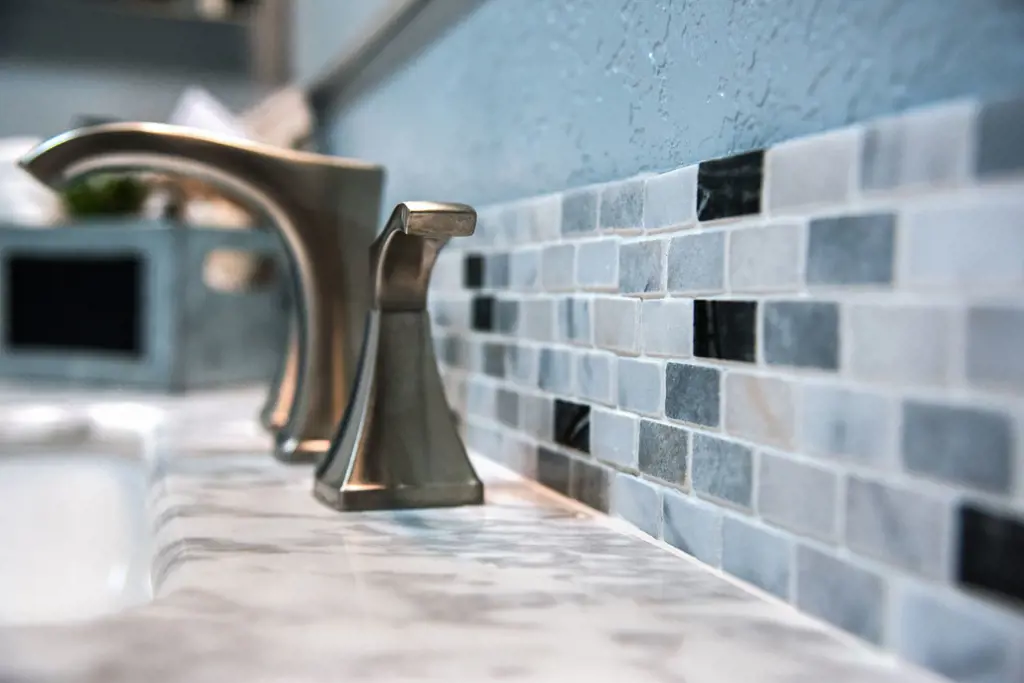
When it comes to designing a bathroom sink area, the backsplash plays an important role. It not only protects the wall from water damage but also adds a decorative element to the space. There are various materials that can be used for a backsplash in a bathroom sink area, each with its own advantages and disadvantages. In this article, we will explore the different materials that can be used and discuss their qualities.
- Ceramic Tiles: Ceramic tiles are a popular choice for bathroom backsplashes due to their durability and versatility. They come in a wide range of colors, patterns, and textures, allowing for endless design possibilities. Ceramic tiles are moisture-resistant, easy to clean, and can withstand heat and humidity.
- Porcelain Tiles: Similar to ceramic tiles, porcelain tiles are also a durable and low-maintenance option for a bathroom sink backsplash. Porcelain tiles are harder and denser than ceramic tiles, making them more resistant to water and stains. They are also available in various styles and finishes to suit any design aesthetic.
- Glass Tiles: If you're looking for a more contemporary and sleek look, glass tiles are an excellent choice. They reflect light, which can make a small bathroom feel larger and brighter. Glass tiles are resistant to moisture and stains, and they are relatively easy to clean. However, they can be more prone to scratches and cracks compared to other materials.
- Natural Stone: Natural stone backsplashes, such as granite, marble, or travertine, add a touch of elegance and luxury to a bathroom sink area. These materials are highly durable and can withstand water, heat, and humidity. Each natural stone has its own unique patterns and colors, providing a one-of-a-kind look. However, natural stone requires regular sealing to prevent stains and requires more maintenance compared to other materials.
- Stainless Steel: For a modern or industrial look, stainless steel backsplashes are a great option. They are resistant to water, heat, and stains, making them easy to clean and maintain. Stainless steel can also withstand harsh cleaning products and is highly durable. However, it may show fingerprints, scratches, and dents more easily than other materials.
- Wallpaper: While not as common as other materials, wallpaper can be used as a budget-friendly option for a bathroom sink backsplash. There are moisture-resistant wallpapers available that can withstand the bathroom environment. However, they may not be as durable as other materials, and caution must be taken to prevent water damage.
In conclusion, when choosing a material for a backsplash in a bathroom sink area, it's essential to consider factors such as durability, maintenance requirements, and design aesthetic. Ceramic and porcelain tiles offer a wide range of possibilities, while glass tiles provide a contemporary look. Natural stone adds elegance, stainless steel offers a modern touch, and wallpaper can be a budget-friendly alternative. Ultimately, the choice will depend on personal preference, style, and budget.
Is it Safe to Wash Rubber Backed Bathroom Rugs in Hot Water?
You may want to see also
Frequently asked questions
Having a backsplash behind a bathroom sink serves both functional and aesthetic purposes. Functionally, it helps to protect the wall from water damage and stains that can occur from splashes and spills. It acts as a barrier between the sink and the wall, preventing water from seeping into the drywall or causing discoloration. Aesthetically, a backsplash can enhance the overall design of the bathroom by adding a decorative element and creating a visually appealing focal point.
While there are a variety of materials you can choose from for a bathroom sink backsplash, it is important to consider the specific requirements of the space. Since the backsplash will be exposed to moisture, it is recommended to use materials that are water-resistant and easy to clean, such as tiles, glass, or stone. These materials are durable and can withstand the daily use and cleaning that a bathroom sink area typically experiences. Additionally, it is important to ensure that the chosen material complements the overall style and design of the bathroom.
Yes, you can install a backsplash behind a pedestal sink. In fact, having a backsplash can help to highlight and enhance the overall elegance and beauty of a pedestal sink. When installing a backsplash with a pedestal sink, it is important to consider the size and positioning of the sink. The backsplash should be sized and placed in a way that complements the sink and does not obstruct its functionality. Additionally, the backsplash should be securely installed to the wall to ensure stability and prevent any potential water damage.




